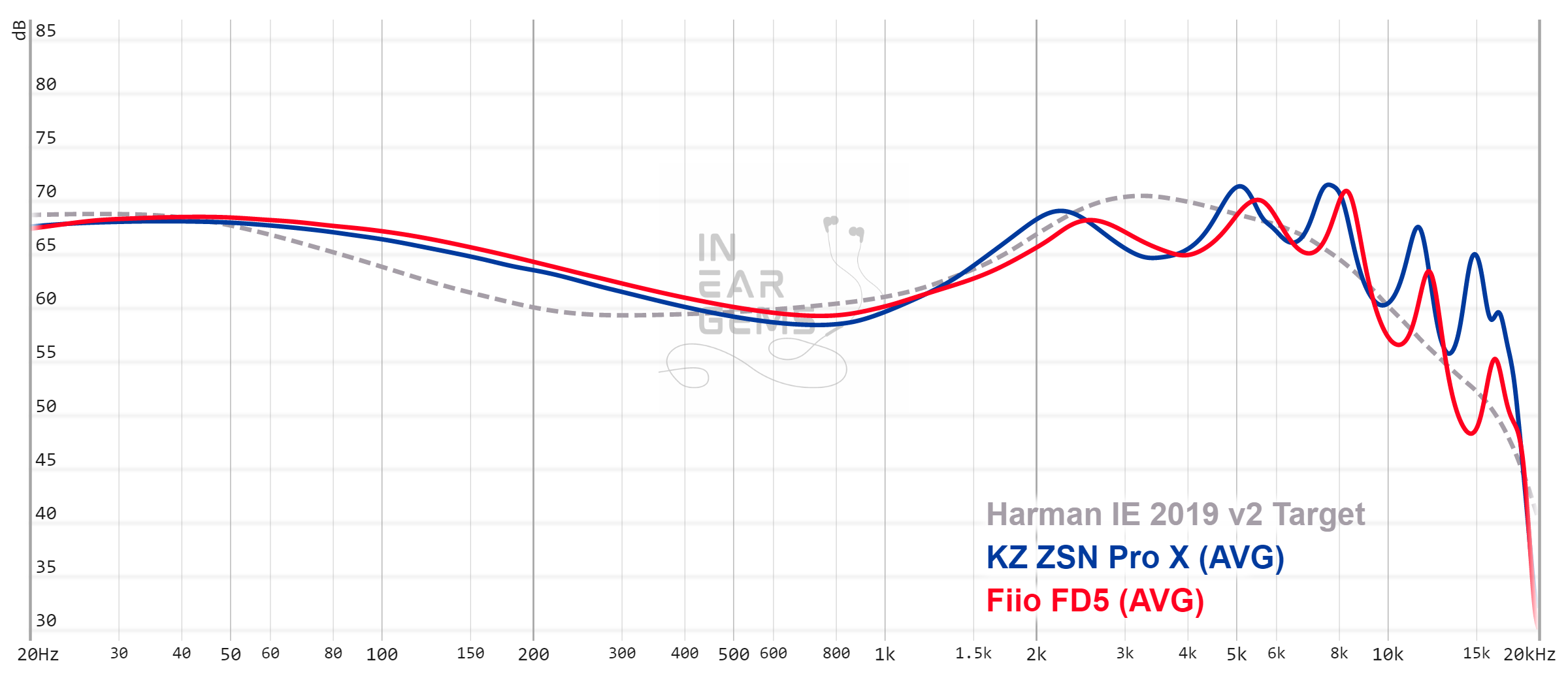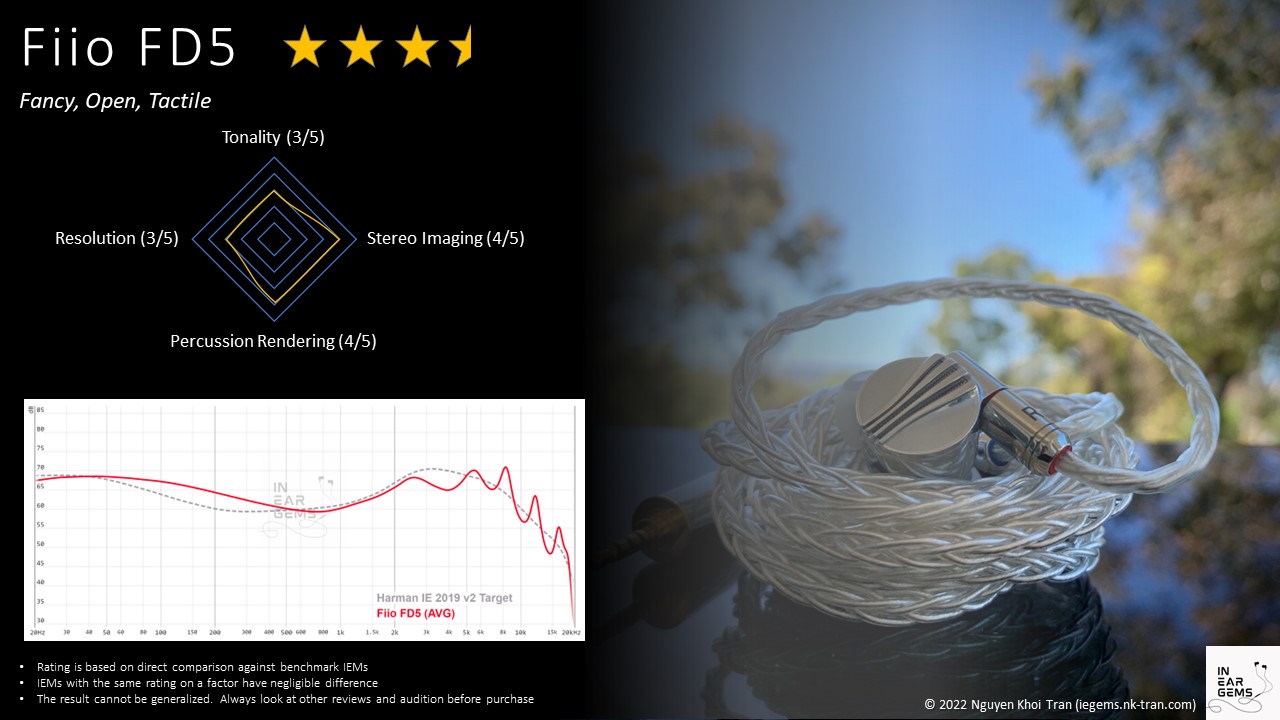Fiio FD5 - Fancy, Open, Tactile
Welcome to another rapid-fire review where I share impressions of audio gear as fast as possible. Today, we talk about my (ex-)darling, Fiio FD5.
Forewords
- I purchase this unit on my own. I have no affiliation with or financial interest in Fiio. This unit costs me AUD $460.
- You should treat this review as the subjective impressions of an audio geek rather than an “objective truth” about the IEM. Your experience with any IEM would change depending on your DAC/AMP, music library, ear tips, and listening volume.
- I rate IEMs by A/B testing them against a few benchmark IEMs, regardless of price point. This approach ensures the consistency of the ratings in my ranking list. It means that if two IEMs score the same, they perform more or less similar.
- I believe that great IEMs are the ones that can achieve multiple difficult things simultaneously: (1) high resolution (meaning lines of music are crisp, clear, easy to follow and full of texture), (2) 3D soundstage with a strong sense of depth, (3) bold and natural bass with a physical rumble, (4) natural timbre, (5) relaxing and comfortable tonality.
- Ranking list and measurement database can be found on my IEM review blog.
Specs
- Driver: 12mm Beryllium-coated DLC diaphragm
- Connector Type: MMCX
- Impedance: 32ohms
- Sensitivity: 109dB@1mW
Non-sound aspects
Luxurious! FD5 was the first high-end IEM that I ever held in my hands. Boy, oh boy, it made a strong impression.** Everything about this IEM screams “expensive”**, from the fancy packaging to the leather case, the braided cable with interchangeable plugs, to the IEMs themselves.
The earpieces are heavy chunks of stainless steel. The cable is also chunky and heavy. Luckily, I have no discomfort even when I wear FD5 for many hours. The open-back design helps to reduce the pressure in the ears to create a comfortable wearing experience. The drawback is that FD5 does not isolate noise well.
How it sounds
Tonality: 3/5 - Average

Looking at different reviews on the Internet, you will find two opposite perceptions of FD5 tuning. One side hails FD5 for its close adherence to Harman In-ear Target, making it a superbly tuned IEM. The other side considers FD5 a mediocre, generic V-shaped tuned IEM.
Both sides are correct. FD5 does express some characteristics of Harman-tuned IEM, primarily the ear-gain compensation from 1kHz and the rolled-off treble. This tuning highlights midrange elements, particularly vocals, and pushes them closer to you while pulling the band further into the background.
At the same time, FD5 is “generic V-shaped” because it boosts the midbass and lower-midrange (150 to 250Hz region) to intensify the “boom boom” sound. Of course, there is nothing wrong with having a few extra bass punches. However, FD5 cannot control the bass very well, so a sense of “mud” spreads over the midrange, impacting its clarity. A cut at 250Hz could have helped deal with this issue.
Another problem with FD5 is the “cat ears” shape in the upper midrange and treble, characterised by the twin peaks at 2.5kHz and 5.5kHz. These peaks sharpen the sound, particularly vocals and note attacks, such as guitar picks or sticks hitting drums, to create the illusion of clarity. However, too much sharpening makes the sound artificial and harsh. These peaks also mask the details around 3kHz. As a result, something always feels missing in the midrange of FD5.
Tuning gimmicks: FD5 includes an extra set of thin nozzles (Etymotic size) to reduce the upper frequencies. Unfortunately, none of the supplied tips works well with these narrow nozzles. Even with suitable tips from Etymotic or Westone, these nozzles still do not sound good, as they silence the treble too much, making FD5 dull.
Percussion rendering and bass: 4/5 - Good
Good, but it could be better.
The tuning of FD5 makes drums very punchy. Bass attacks are sharp and snappy with a unique tactile feeling, like air pushed against your ears.
However, I always feel drums lack body with FD5 because there is not much rumble to accompany the “boom” sound. The lack of sub-bass is quite apparent when I compare FD5 with sub-bass-focused IEMs such as Blessing 2 or my FH3.
Resolution: 3/5 - Average
I can accept the mid-bass-focused rendering. I can even tolerate the cat ears tuning.
However, I cannot turn a blind eye to the (lack of) resolution of FD5.
FD5’s resolution is not poor. It’s not good, either. As I mentioned above, the lack of control over the bass casts a “veil” or “mud” over the midrange of FD5, making everything a little bit less separated and overly smoothened. The presentation here lacks refinement.
The cat ears tuning can improve the clarity of the elements at the centre of the soundstage. However, when you shift your attention to details, such as backing vocals at the sides of the stage, you will see that they are blurry and barely intelligible. This kind of resolution is a far cry from the infamous Blessing 2, which retails at the same price as FD5.
Soundstage imaging: 4/5 - Good
Soundstage imaging is a bright spot of FD5’s performance. The open-back design helps FD5 project a wide, open soundstage free of the sonic wall. As a result, orchestral music sounds large and epic with these IEMs.
The drawback of FD5’s soundstage lies in its slightly blurry imaging. Simply put, instruments feel like hazy blobs coming from various directions on the soundstage. This haziness prevents FD5 from projecting an impressive “3D” soundstage where instruments pop up at different distances and layering up from closer to further away. I suspect this limitation is related to the average resolution.
Conclusion
This review is a farewell to an old friend. As I rarely use FD5, it has been sent off to another owner who is head over heels for it and couldn’t stop listening to it. If you consider FD5, I highly recommend an audition before bringing one home. It might just be the perfect IEM for you.
Pros:
- Wide and open soundstage
- Fun bass
- An interesting sense of tactility to the sound
Cons:
- Average resolution
- Slightly blurry imaging
- Tuning can sound harsh and artificial

